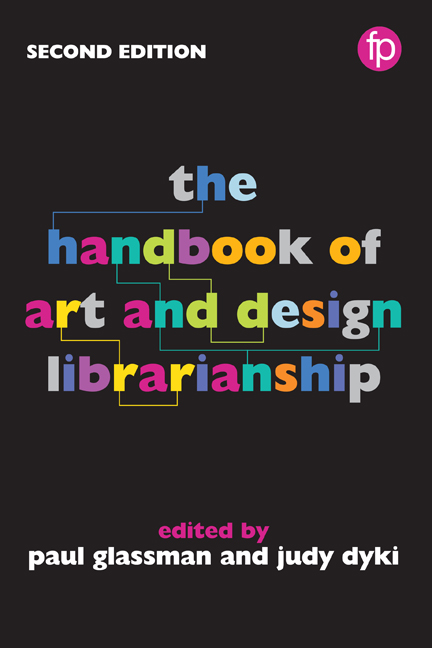Book contents
- Frontmatter
- Contents
- List of figures and tables
- Notes on contributors
- Foreword
- Preface
- Part I Roles and responsibilities
- 1 The governance and administration of the art and design library
- 2 Evolution not revolution: evolving trends in art and design libraries
- 3 Expanding roles for fine arts liaison librarians: re-visioning the liaison model
- 4 Accreditation and visual arts libraries
- 5 Design thinking for design librarians: rethinking art and design librarianship
- Part II Materials and collection management
- Part III Teaching and learning
- Part IV Knowledge creation
- Part V The physical environment
- Part VI Promotion and sustainability
- Appendix Library profiles
- Index
1 - The governance and administration of the art and design library
from Part I - Roles and responsibilities
Published online by Cambridge University Press: 08 June 2018
- Frontmatter
- Contents
- List of figures and tables
- Notes on contributors
- Foreword
- Preface
- Part I Roles and responsibilities
- 1 The governance and administration of the art and design library
- 2 Evolution not revolution: evolving trends in art and design libraries
- 3 Expanding roles for fine arts liaison librarians: re-visioning the liaison model
- 4 Accreditation and visual arts libraries
- 5 Design thinking for design librarians: rethinking art and design librarianship
- Part II Materials and collection management
- Part III Teaching and learning
- Part IV Knowledge creation
- Part V The physical environment
- Part VI Promotion and sustainability
- Appendix Library profiles
- Index
Summary
Introduction
Whether supervising a professional library with support staff members or acting as solo librarian in a one-person library, the library manager will benefit from basic administrative tools. Starting with questions about parent organization's governance structure, this chapter recommends essential administrative and managerial tools for the art and design library: the mission statement, long-range or strategic planning, shorter-range annual plans (known also as operating or business plans), fundamentals of administration, promotion and advocacy, financial support, management of materials (the library's non personnel assets) including electronic resources, performance appraisal and accreditation.
Governance
Notably, among the first aspects of art and design libraries examined by the National Association of Schools of Art and Design (NASAD; https://nasad.arts accredit.org) is governance. The UK Arts and Design Institutions Association (www.ukadia.ac.uk/about/ aims-objectives) also emphasizes best practices in administration and defines one of its goals as ‘To provide a platform to share good practice in academic development and managerial effectiveness for specialist arts and designs institutions’. Even if you are not engaged in an accreditation self -study, it may be useful to understand the relation of the library to its administration.
In discussing library governance, NASAD states: ‘The functional position of the art/design collection within the total library structure shall be clearly identified, and the responsibilities and authority of the individual in charge of this collection shall be defined’ (NASAD, 2016–17, 65).
The organizational structure of the design library in relation to the larger context of the academic library varies within institutions: it may be a collection within a central library; it may be a branch library; it may also be either of these with the addition of a resource, materials or product collection in proximity to the studios. This chapter will describe a variety of scenarios and management tools.
In understanding the governance of the larger institution, the librarian will develop an awareness of the larger institutional culture and degree of collegiality. These relationships can be understood by examining the reporting structure for and within the library, which might be expressed through an organizational chart that addresses these questions:
• To whom is the library director accountable, and who supervises that individual?
• Who develops and administers policy for the library?
• Do the librarians have faculty rank and status?
• If so, do they serve on a faculty or academic senate?
- Type
- Chapter
- Information
- The Handbook of Art and Design Librarianship , pp. 3 - 14Publisher: FacetPrint publication year: 2017



